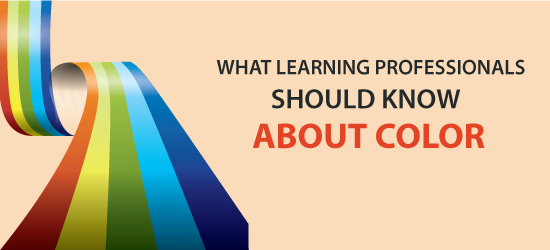
Do the graphic designers you know speak in a secret language? Do you wish you could let terms like hue, saturation and value roll off your tongue? Understanding color terminology is important for knowing how to use color in instructional design.
Importance of Color in Instructional Design
Aside from impressing your friends, there are practical reasons for learning more about the use of color in instructional design. eLearning and slides are visual mediums. Learning about color will help you become more discriminating and sophisticated in your visual choices. You’ll better understand how to use color to facilitate learning. And it will enhance your collaboration with graphic designers, illustrators, artists, animators, photographers and videographers.
Learning and the Effect of Color
Color is always a good place to start because it’s a key component of visual communication. Color helps us represent reality, provide focus, express emotion, connect information, increase legibility and create psychological impact.
One of the main goals of designing learning and informational materials is to reduce the cognitive effort required to understand them. Color can help with this because people derive meaning from colors, providing another dimension for sense-making. Some ways that color enhances meaning and improves learning are listed below.
- Improves visual discrimination. In situations where novices are learning to visually discriminate, such as materials that teach how to read radiographs, you can highlight hard-to-see markings with a very distinct color.
- Color coding works as a signal. Use color coding to coordinate text explanations with corresponding graphics. A small shape of color, rather than colored text works best. To accommodate people who are color blind, use an additional visual signal, such as an icon.
- Enhances storytelling. Color is valuable for enhancing the meaning of stories. As an example, in an illustrated story, a red face conveys embarrassment or anger. Using color to convey an emotional response can improve comprehension of the story.
- Evokes emotion. Color has an emotional impact on a viewer. Warm colors (red, yellow, orange) are known to excite and stimulate and cool colors (blue and green) are calming. Make color choices with an awareness of their affect on the audience.
Color Perception
The perception of color varies among individuals. Color perception is affected by the brightness of ambient light, the colors that surround it and how an individual’s eyes and brain process visual information. It’s always good to remember that a certain percentage of the population is color-blind, meaning they have difficulty discriminating certain colors, usually red and green hues.
In order to accommodate anyone who is color-blind, use a secondary approach when using color as a signal. For example, when using color-coding, also use matching icons to indicate what goes together.
Color Terminology
Color has many dimensions. Having a basic color vocabulary will help you communicate and think about color in terms that most visual communicators understand.
![]() Hue: Hue is the identity of the color, such as red, green or violet. It is the quality that allows us to discriminate colors. When we perceive a hue, it means its wavelength is in our visible spectrum, which ranges from red (long wavelength) to violet (short wavelength).
Hue: Hue is the identity of the color, such as red, green or violet. It is the quality that allows us to discriminate colors. When we perceive a hue, it means its wavelength is in our visible spectrum, which ranges from red (long wavelength) to violet (short wavelength).
![]() Saturation: Saturation (or chroma) refers to the purity, intensity or strength of a color. The vivid blue on the left has a high saturation and the dull blue on the right is desaturated. Neutral colors are desaturated.
Saturation: Saturation (or chroma) refers to the purity, intensity or strength of a color. The vivid blue on the left has a high saturation and the dull blue on the right is desaturated. Neutral colors are desaturated.
![]() Value: Value refers to the relative darkness or lightness of a color and makes sense when colors are being compared. Increasing the percentage of black to the orange hue on the left transformed it to the brown on the right.
Value: Value refers to the relative darkness or lightness of a color and makes sense when colors are being compared. Increasing the percentage of black to the orange hue on the left transformed it to the brown on the right.
Color Tips and Ideas
Once you understand the dimensions of hue, saturation and value, you can begin to understand the way colors affect each other. Playing around with varied saturation and values in a graphic editor will give you a better sense of these dimensions. See Five Free Image Editors Worth Trying if you need a way to modify and create graphics.
Working with Colors Every Day
Here are some color tips you can use, now that you’re an expert.
- How to make richer colors: To make a color richer, increase its saturation by darkening the value (increasing the percentage of black) up to a point. Too much black will detract from the color’s intensity.
- How to find alternatives to gray scale: When you turn a color photograph to black and white, you are removing the hue but keeping the values in tones of gray. For a different effect, use another single color, such as sepia or blue to create a photo of monochromatic tones.
- How to increase contrast: Study the color spectrum or a standard color wheel. Note that colors next to each other in the spectrum can be difficult to discriminate. If you want to be sure viewers can discriminate between two adjacent regions, such as areas of a map or bars in a bar chart, then don’t select colors that are next to each other in the spectrum. Select colors that have one or two steps in between.
- How to remove salience: If you don’t want any one object or item to stand out among the rest, tone down the brightness and desaturate the colors. This will convey that all the objects are of equal value. Of course, the reverse is true. Increase the brightness and richness of a color if it’s meant to stand out.
- How to avoid color chaos: Before selecting or approving a color scheme, think in terms of color relationships. Test the foreground colors on the proposed background colors. Because background colors can make a foreground color appear brighter or duller, make sure you like the effect of juxtaposed colors. See 8 Ways to Choose a Color Palette for ideas.
Reference:
- Malamed, Connie. Visual Design Solutions. Wiley, 2015.
Get the latest articles, resources and freebies once a month
plus a Visual Design Cheat Sheet.

Unfortunately, this is all too common, Charlene. I recommend making a case to modify the branding colors and fonts (if necessary) for learning products. You’ll need to explain or do an entire presentation about what is involved in learning (how people learn) and how that is different than advertising and marketing. Let them know that learning involves retention, application and transfer of knowledge and skills. Tell them about cognitive load (I have articles on this site and there are many books on learning science) and how to reduce cognitive load, you need accent colors to point things out, to create contrast, and to show learners where to look. This reduces the time and confusion of finding what you want. I’m surprised that a marketing group wouldn’t have an accent color in their palette! Good luck!
My current client is insisting on only the usage of brand colors. They have two shades of blue, two shades of gray, white and black —- I asked for one or two accent colors, and they won’t allow it.
What are your thoughts about companies requiring only the usage of their brand colors? How can I approach them and ask for an exception for eLearning?
Thank you —
Thank for the tools Brian and for the reminder about color and accessibility.
I really dig http://colorsafe.co/ for finding accessible color palettes for projects.
And if you’re using text over a color or image, be sure to check it on https://contrastchecker.com/.
Thanks for adding this information about W3Cs content on accessibility. Here is the link: https://www.w3.org/standards/webdesign/accessibility
Connie
Thank you for an engaging, informative post regarding the importance of color considerations, especially in instructional design. I have recently been involved with updating my organization’s Web site so that it is Web Accessible according to the World Wide Web Consortium (W3C)’s WCAG standards. This involves improving the experience of users with various abilities and color is a strong consideration. Thank you for addressing colorblindness, suggesting the use of symbols and numbers to coordinate to visual indicators, and to select contrasting colors for clarity! More details on color contrast ratios and creating visual indicators to signal interactive links can be found on the W3C’s Tips on Designing for Web Accessibility Web page. Being instructional designers, these are important things to consider, since it pertains to our clients and their consumers.